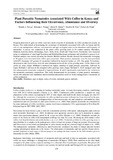Plant Parasitic Nematodes Associated With Coffee in Kenya and Factors Influencing their Occurrence, Abundance and Diversity

Date
2014Author
Maundu, J. Nzesya,
Kimenju, J. Wangai
Muiru, W. Maina,
Wachira, M. Peter
Gichuru, K. Elijah
Type
ThesisLanguage
enMetadata
Show full item recordAbstract
Frequent detection of galls on coffee roots has raised concerns of nematodes in coffee production systems in
Kenya. This study aimed at determining the occurrence of nematodes associated with coffee in Kenya and the
role of crop management, cultivars, soil properties and agro ecological zones on the abundance and frequency of
nematodes. A survey was conducted in the prime coffee growing areas in 10 counties namely; Machakos,
Makueni, Kiambu, Embu, Kirinyanga, Nyeri, Meru, Kisii, Nandi and Trans-Nzoia. Nematodes were extracted
using a combination of centrifugal floatation and Modified Baermann techniques and identified to genera level.
Nutrient analysis was carried out using the Double Mehlich method. Results showed that nematodes belonging
to 30 genera were recovered from coffee agro-ecosystems. Plant parasitic nematodes were the most prevalent
with 64% frequency (19 genera) of occurrence followed by bacterial feeders at 24%. The genus Tylenchulus,
Meloidogyne and Pratylenchus were the most dominant across all the coffee growing areas. Coffee farms in the
coffee-tea zones (Upper Midland 1) harbored the highest numbers of plant parasitic nematodes, followed by
Upper Midland 2 and least in the marginal coffee growing zones (Upper Midland 3). Well managed farms had
less plant parasitic nematodes compared to neglected farms. K and P significantly contributed to the variation in
the nematode community composition. This study demonstrated the prevalence of plant parasitic nematodes,
factors that influence their abundance and distribution and justifies need for further management of nematodes in
coffee production.
Key words: Abundance, agro-ecologial zones, diversity, nematode genera, nutrients
Citation
Maundu J. Nzesya, Kimenju J. Wangai, Muiru W. Maina, Wachira M. Peter, Gichuru K. Elijah (2014).Plant Parasitic Nematodes Associated With Coffee in Kenya and Factors Influencing their Occurrence, Abundance and Diversity. Journal of Biology, Agriculture and Healthcare, 4(3), 120-129Publisher
University of Nairobi
